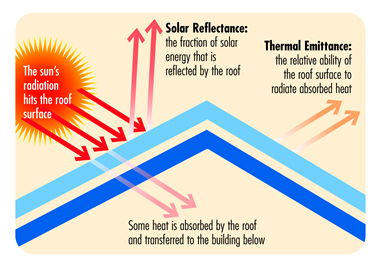What is a Cool Roof?
A cool roof is one that reflects the sun’s heat and emits absorbed radiation back into the atmosphere. The roof literally stays cooler and reduces the amount of heat transferred to the building below, keeping the building a cooler and more constant temperature. Imagine wearing a white or a black T-shirt on a hot day. By wearing the white T-shirt you will remain cooler than if you wore a black T-shirt because it reflects more sunlight and absorbs less heat. Cool roofs like a white T-shirt, keep the internal temperature of the building cooler.
However, a cool roof need not be white. There are many “cool color” products which use darker-colored pigments that are highly reflective in the near infrared (non-visible) portion of the solar spectrum. With “cool color” technologies there are roofs that come in a wide variety of colors and still maintain a high solar reflectance.
The two basic characteristics that determine the ‘coolness’ of a roof are solar reflectance (SR) and thermal emittance (TE). Both properties are rated on a scale from 0 to 1, where 1 is the most reflective or emissive.
The CRRC measures these two properties for roofing products, both for the product’s initial values and after three years of weather exposure. The CRRC publishes the results on the online Rated Products Directory. The online Directory is available to the general public at no charge, and it allows you to compare the rated values of various product types and brands.
What are the Benefits of a Cool Roof?
There are numerous benefits in having a cool roof:
-
Increase ecological sustainability factor, or make your house “greener” by:
-
Reducing your utility bills associated with air conditioning
-
Increasing occupant comfort and avoid installing an air conditioner where there isn’t already one
-
Decreasing the size and prolong the life of your air conditioning system
-
Lowering roof maintenance costs and extend roof life, avoiding reroofing costs and reducing solid waste
-
Assist your home in meeting building codes
-
Mitigate your community's Urban Heat Island Effect
-
Maintain aesthetics with a roof that performs and looks good
-
Receive utility rebates (in some locations)
-
Why Cool Roofs are Way Cool
In a nut shell, a cool roof can significantly reduce your cooling energy costs and increase your comfort level by reducing temperature fluctuations inside your home. Average energy savings range from 7%-15% of total cooling costs.
When people think about making their home more “green” or ecologically sustainable, cool roofing isn’t always the first thing to come to mind. However, certain green building programs, such as the U.S. Green Building Council’s LEED, give credit for installing a cool roof. So if you are trying to save energy or make your home more environmentally-friendly, a cool roof is one way to achieve that goal.
What is the right roofing material for your home or building?
Although the CRRC cannot recommend specific roofing products, below is a description of some things to consider in selecting a roofing product for your building, including a description of the types of roofing materials currently rated in our program.
Slope
All roofs essentially fall into one of two general categories: low-slope (less than 2 inches of rise over 12 inches of run) and steep-slope (2:12 or greater). Our directory indicates which slope(s) a product is intended for. In addition, we recommend that you check with a local roofing contractor, roof consultant or architect to determine the most appropriate roofing product type for your home.
Climate
In most climate zones worldwide, cool roofs can significantly reduce a building’s cooling load. However, cool roofs can also increase heating costs in winter months. This increase is usually greatly outweighed by the cooling energy savings achieved during summer months because the sun is low in the sky during winter months, the weather tends to be overcast, and snow often covers the roof, usually making the heat gain through the roof negligible in all but the most northern climate zones in the US.
In selecting your roof, it is important to understand your climate zone and the actual energy your home or building will save. There are two cool roof calculators available online that can give good estimates of how much energy you will save. You can find them at: Cool Roof Calculator

